Summary:
- You Aren’t Targeting the Right Audience
- You Don’t Have Permission to Email Subscribers
- Your IP Address Is or Has Been Used for Spam
- You Have Low Engagement Rates
- Your Subscribers Don’t Remember You
- You Have Low Mailbox Usage
- Your Subject Line is Misleading
- Your “From” Information Is Inaccurate
- You Don’t Include Your Physical Address
- You’re Not Learning From Your Mistakes
- You’re Using Spam Trigger Words
- Your HTML Emails Don’t Follow Best Practices
- Your Email Isn’t Properly Authenticated
- Your Email Attachments Trigger Spam Filter
- You’re Sending Emails Inconsistently
Why are my emails going to spam? Do you often find yourself asking this question? Well, you’re not alone.
Email marketing has become an integral part of every business. However, a major challenge businesses face is having their emails land in the recipient’s spam folder instead of their inbox.
This frustrating problem can severely affect your email marketing campaign and business communications.
In this blog post, I’ll discuss 15 reasons why your emails are going to spam and provide tips on how to prevent it from happening.
By the end of this post, you’ll not only have your answer to “Why do my emails go to spam” but also know exactly how to get back to your subscriber’s inbox.
Video Tips for Avoiding Spam Filters
If you prefer written instructions with more details, then please continue reading.
Understanding Spam Filters
Before we explore why your emails are going to spam, it’s important to understand how spam filters work.
Spam filters are software programs that scan incoming emails for unsolicited or dangerous emails and classify them as either spam or legitimate. There are different types of spam filters, but they all have a common goal, to protect users from unwanted and potentially harmful emails.
Spam filters use various criteria to determine whether an email is spam. These criteria may include the following but are not limited to:
- sender’s reputation
- email content
- presence of attachments
- email’s format
- recipient’s behavior
If an email meets the spam filter’s criteria, it’s classified as spam and sent to the recipient’s spam folder.
💬 “Mailbox providers like Gmail use hundreds of signals to determine whether an email is spam — including user behavior, domain reputation, and authentication protocols like SPF, DKIM, and DMARC.”
— Litmus, Email Deliverability Basics
First, let’s start with all the reasons why emails go to spam in the first place. Then, we’ll dive headfirst into some actionable solutions to get your emails back in your subscribers’ inbox where they belong.
How We Found These 15 Reasons
This guide isn’t based on guesswork or scraped email marketing advice.
At OptinMonster, we run email marketing campaigns every week to power our own business, including onboarding sequences, product updates, newsletters, and automations. Like many of our users, we’ve faced the frustration of emails going to spam and have tested dozens of fixes to improve deliverability.
On top of that, we’ve supported thousands of users in improving their lead quality and email list health through our tools — like TruLead® for lead verification and Double Optins to prevent fake or disengaged subscribers from joining in the first place.
Combined with deliverability testing tools like Mail-Tester, IsNotSpam, and Litmus, and by analyzing patterns across our campaigns and customer insights, we’ve narrowed down the top 15 reasons emails most commonly end up in the spam folder.
Why Are My Emails Going to Spam
Let’s take a detailed look into the 15 reasons why your emails aren’t getting past the spam filters and are going to the spam folder.
1. You Aren’t Targeting the Right Audience
Low engagement from the wrong subscribers signals spam filters. Target only your ideal audience.
Why is this a problem?
When your emails are inaccurately marked as spam, it could be because you have low engagement rates. One of the tell-tale causes of low engagement rates is having the wrong audience on your email list in the first place.
Every marketer tries to grow their email list as large as possible. And considering the importance of email marketing, they should improve their email list as much as possible.
But rather than simply getting more subscribers, marketers must focus on getting the right subscribers. How can they do that?
Here’s the solution:
By using targeted optin campaigns with OptinMonster:
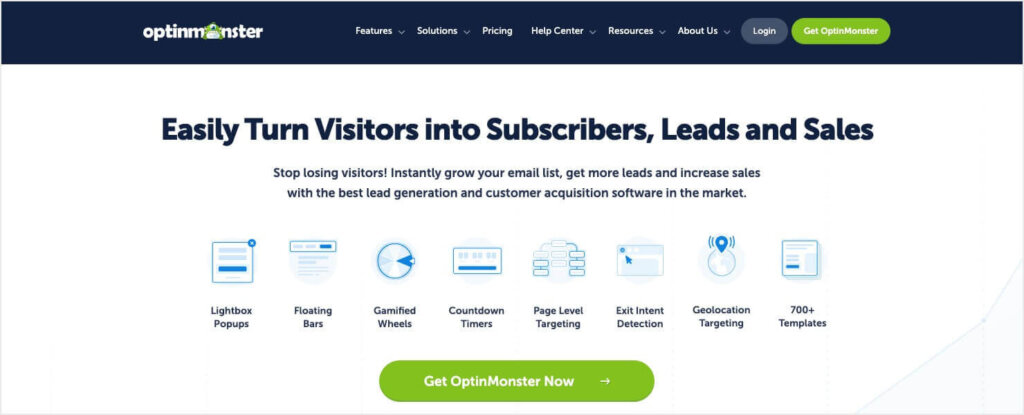
OptinMonster allows you to create optin campaigns that target exactly the audience you’re looking for. Because we offer many different targeting options, you don’t need to cast out a net to get leads blindly.
Instead, you can set up various display settings and triggers to make sure you’re only adding people who fit your buyer persona.
As a result, your engagement rates will rise, and your emails will be sorted to the right place.
2. You Don’t Have Permission to Email Subscribers
Emailing people without consent often leads to complaints — a fast track to the spam folder.
Why is this a problem?
The #1 rule of email marketing is to get permission to email first. Along the same lines, you should never buy a list of email addresses. When you email people who didn’t choose to subscribe to your list, a lot of them will flag your messages as spam. This will signal to email servers that you’re not a reputable sender, and they’ll likely start filtering your emails directly into spam boxes.
Plus, many countries legally require you to attain explicit permission before sending marketing emails. For example, in the European Union, you must make sure you maintain GDPR compliance in your email marketing.
Here’s the solution:
To get permission, you’ll need an opt-in form on your site that clearly indicates that visitors are subscribing to your email list.
Here’s an example of OptinMonster’s sidebar optin form:
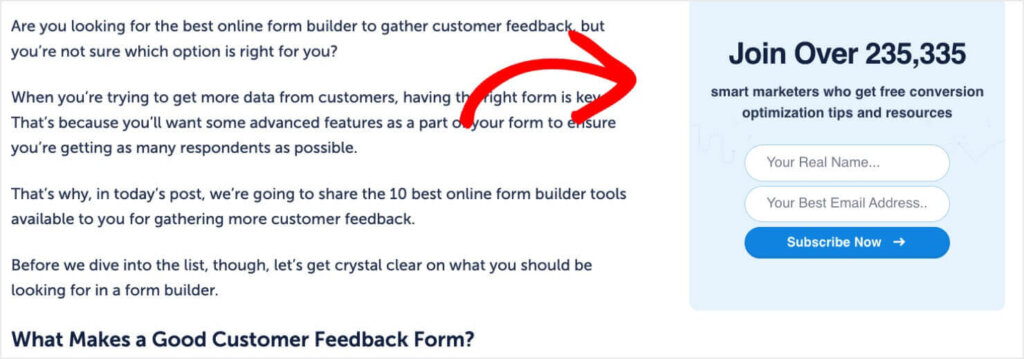
When a user fills out this optin form, it’s crystal clear they’ll be joining OptinMonster’s email list.
Another way that marketers harm their email campaigns is by manually adding emails that they get from business cards collected at a conference or from social media.
Let’s be clear on this: Don’t do that.
While you may think they would appreciate your newsletter, sending emails to them violates the CAN-SPAM Act because they did not give you permission.
Instead, you should send those leads personalized emails rather than templated newsletters. Follow up with a separate drip campaign, personal email, or autoresponder series designed just for those leads and give them a chance to optin to your newsletter.
3. Your IP Address Is or Has Been Used for Spam
Shared IPs with bad senders can hurt your reputation. Use trusted email platforms.
Why is this a problem?
Even if you never send spam yourself, your emails could get flagged if your IP address was used for spam in the past.
If you send your campaigns through an email marketing service, your email is delivered through their servers. So if even one other customer sends spam, it could also affect your deliverability.
Here’s the solution:
Only use that every email marketing service which is vigilant about keeping their reputation intact. They have strict procedures and regulations to prevent this type of thing.
You should be fine if you stick to a reputable ESP (email service provider). And while we can’t verify every ESP in this post, we recommend Constant Contact, Drip, and Brevo (Sendinblue).
We know for a fact that these three providers take email deliverability seriously. Thus, they don’t let spam connect to their server’s IP address.
4. You Have Low Engagement Rates
Low open or click rates tell inbox providers your emails aren’t wanted. Keep lists fresh and content relevant.
Why is this a problem?
We already discussed the importance of getting high engagement rates.
Top webmail providers have stated that they look at how many emails are opened and how many are deleted as a factor in spam filtering decisions.
So if you have low open or read rates, your emails are at higher risk of being flagged as spam. You need to do everything you can to increase engagement.
Here’s the solution:
Other than targeting the right audience from the start, you can send your emails at the right time, perfect your subject lines, segment your list, and keep your list fresh by scrubbing it regularly.
For more detailed tips on how to increase your open rates, read our post on ten easy ways to improve your email open rate.
5. Your Subscribers Don’t Remember You
If subscribers don’t recognize you, they might mark your emails as spam. Stay consistent and branded.
Why is this a problem?
The second most common reason emails never reach the inbox is spam complaints.
Every time a subscriber reports an email as spam, the mailbox provider records the complaint regardless of whether or not the email was spam.
Once the complaints exceed a certain threshold, all future campaigns skip the inbox and get sent directly to the spam folder.
So why would a subscriber flag your email as spam if it isn’t?
Well, the most likely reason is that they don’t remember you. Even though they gave you permission to email them, they don’t remember doing it, so they think you’re sending them spam.
Here’s the solution:
To prevent this from happening, make sure that the branding in your emails is memorable and matches the branding on your website. This includes any images, colors, typography, and voice. Also, make sure the sender’s name is one they’ll recognize.
It also helps to personalize your email copy to the person you’re sending it to. Here’s an example from an OptinMonster email that includes:
- Our company’s name where the recipient can see who the sender is
- Consistent branding with our website
- Personalized introduction by first name

Even if subscribers forgot they signed up with OptinMonster, we use these small cues to remind them that we’ve started the relationship.
6. You Have Low Mailbox Usage
Inactive or abandoned email accounts drag down deliverability. Clean your list regularly.
Why is this a problem?
In their spam filtering algorithms, email service providers look at the ratio of active to inactive email accounts on your list. An inactive email account is an account that hasn’t been used for a long time or is rarely used.
If you’re mailing a campaign to a large number of email addresses that appear to be inactive, that’s a red flag to spam filters.
Here’s the solution:
To prevent this, clean up your email list periodically of any subscribers who haven’t engaged with your campaigns in a while.
You can do that by sending a win-back email to increase engagement. This is a way of giving your audience one last chance to start engaging with their company before you remove them from your email list. Here’s a good example:

Notice the email copy is direct and addresses the situation head-on. Then, the call to action (Yes, Keep ‘Em Coming) encourages users to reengage.
Depending on your email service provider, you can do this automatically. Some providers include a feature to purge any emails from your list that look inactive automatically.
7. Your Subject Line is Misleading
Deceptive subject lines create distrust and can violate email laws. Be clear, honest, and on-brand.
Why is this a problem?
As the CAN-SPAM act states, it’s against the law to intentionally mislead someone with your subject line to induce them to view the email message.
In a survey conducted by Litmus and Fluent, over 50% of participants stated that they’ve felt cheated, tricked, or deceived into opening a promotional email by a false subject line:
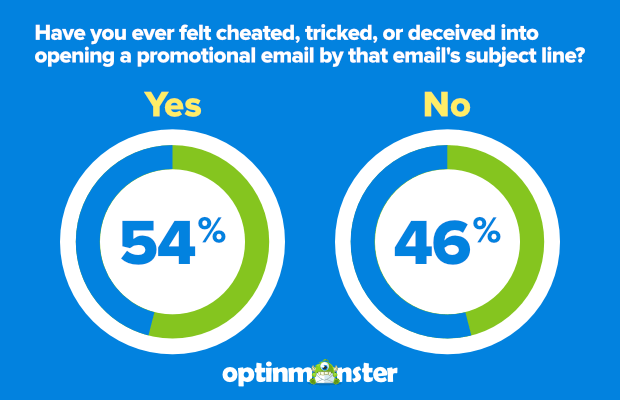
Here are some examples of misleading subject lines:
- Did I leave my jacket at your place? This type of subject line can be used as a trick to make it look like they know you.
- RE: CURRENTLY IN OFFICE is doubly sneaky because it can be mistaken for a reply to your email or a work-related email.
- Urgent – Update your information. If something says “urgent,” it had better be urgent.
- Thanks for your order! It’s super poor form to use a transactional subject line if the email isn’t actually transactional.
We know what you’re thinking. “Why would anybody do something like this? These are some super shady tricks.”
You’re so right. But there are also some gray areas you should avoid, too. Here’s one that recently came to our attention by Russel Brunson:
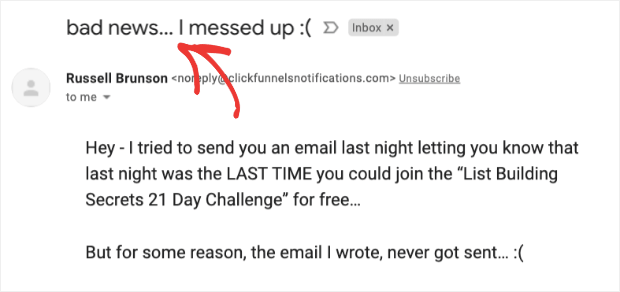
Now, don’t get us wrong. We’re big fans of Russel and the work he does with ClickFunnels. But this subject line seems conveniently misleading.
It says, bad news… I messed up 🙁 and does a fantastic job building curiosity. The problem?
It’s clearly a sales tactic to create a sense of urgency. The idea is that there’s a big sale that you didn’t hear about because Russell “messed up.”
The reader is left feeling like they got a better deal from the error, and the subject entices them to open the message.
Here’s the solution:
This is a grey area tactic you should avoid. Instead, find a better way of creating strong subject lines that aren’t misleading and are 100% honest. Remember, Russel can afford to take that risk. He’s got millions of dollars in savings and a thriving company that could take a hit.
If you don’t have the same security, playing with email subject lines isn’t worth the risk.
8. Your “From” Information Is Inaccurate
Spam filters flag vague or misleading sender names. Use a recognizable and trustworthy sender identity.
Why is this a problem?
It’s also against the CAN-SPAM ACT to mislead anyone with your “from,” “to,” “reply-to,” and routing information.
For example, if you made your email look like it’s from the President, that would be illegal. It’s an extreme example, but you get the point.
Here’s a real-life example from a popular scam during the COVID-19 pandemic:

This email is falsely credited to the UK government. Shady practices like this are illegal and should be avoided at all costs.
Here’s the solution:
As a best practice, make sure you include a name in the “from” field that your subscribers are likely to remember and don’t change it too often. It could be the name of an individual, your company name, or a combination of the two.
Like we showed earlier, we send emails with a personal name from our General Manager and OptinMonster’s brand name:

Whichever you choose for your brand, shoot for memorability and consistency.
9. You Don’t Include Your Physical Address
Missing a business address violates regulations and triggers red flags. Add one to your email footer.
Why is this a problem?
Missing a physical mailing address in your emails can raise red flags for your subscribers’ email providers. This can result in your emails being blocked or flagged as spam, leading to bounced emails and complaints.
Here’s the solution:
You legally must include your physical address. That can be your current street address, a post office box registered with the U.S. Postal Service, or a private mailbox registered with a commercial mail-receiving agency established under Postal Service regulations.
Generally, you include your physical address in the footer of your email.
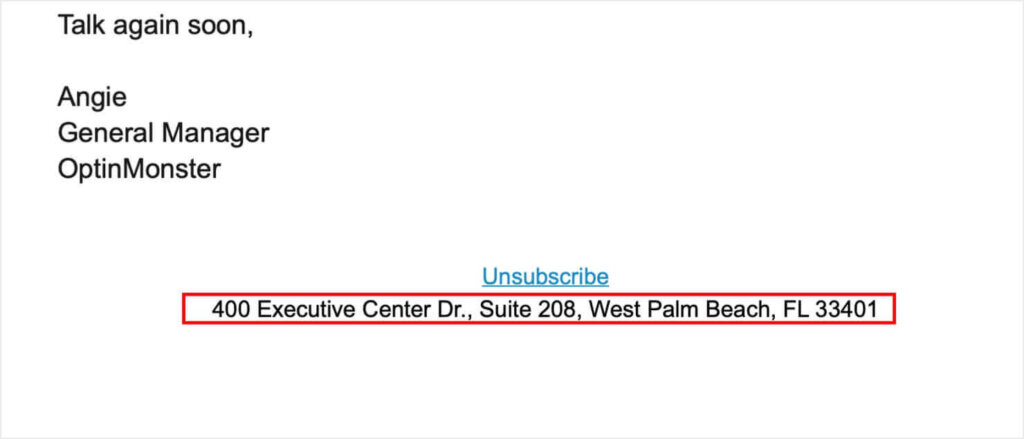
If you don’t have a business address because you work from home?
You should definitely get a PO box for business purposes so you don’t have to broadcast your home address.
10. You’re Not Adding an Unsubscribe Button
Making it hard to opt out leads to spam complaints and legal risk. Include an easy-to-find unsubscribe link.
Why is this a problem?
No matter how valuable you think your email campaigns are, you still need to give your subscribers a way out. If you don’t, you could get spam complaints at best or be slapped with thousands of dollars in fines at worst.
When you email subscribers and don’t include a link to opt out, you risk violating the CAN-SPAM Act and may be subject to penalties of up to $16,000. Oh, and that’s $16,000 per email.
That means if you’ve been sending an automated email series to people who haven’t permitted you, you’re looking at hundreds of thousands of dollars in fines.
Here’s the solution:
At the bottom of your emails, include an unsubscribe link or a similar opt-out feature.
To make sure recipients don’t report you as spam, you’ll want to make your unsubscribe link easily accessible. That way, they’ll simply opt out of your list instead of flagging you as spam:
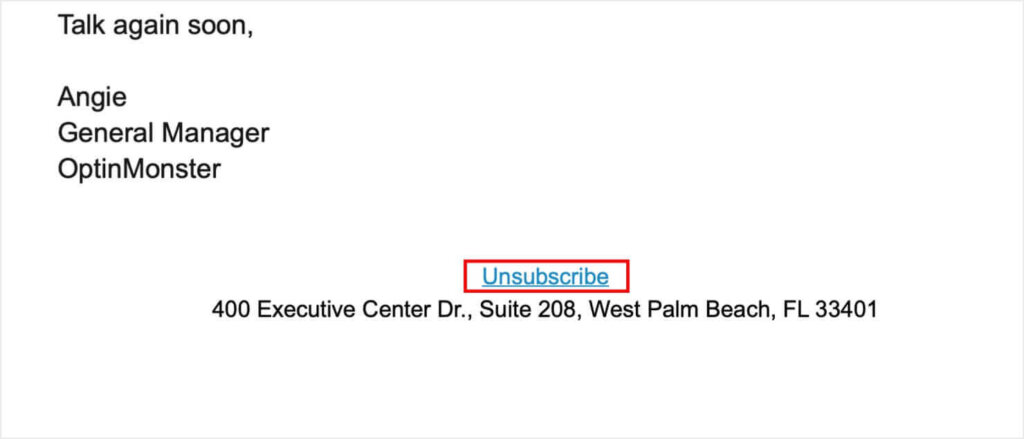
Notice how “easily accessible” doesn’t mean you’re encouraging readers to unsubscribe. Most email recipients are trained to look for the Unsubscribe button at the bottom of your email. So make sure it’s there, but don’t draw unnecessary attention to it.
Bonus Tip: Many people unsubscribe because they simply get too many emails. Alongside your “Unsubscribe” link, consider adding a “Manage Preferences” link that allows subscribers to choose their email frequency. For instance, you could offer an option to receive only one email a week.
11. You’re Using Spam Trigger Words
Certain words can trip spam filters instantly. Avoid common red flags like “Free” or “Act Now.”
Why is this a problem?
Specific words in the subject line or the email’s body trigger spam filters. Some spam trigger words are:
- Amazing
- Cancel at any time
- Check or money order
- Click here
- Congratulations
- Dear friend
- For only ($)
- Free or toll-free
- Great offer
- Guarantee
- Increase sales
- Order now
- Promise you
- Risk-free
- Special promotion
- This is not spam
- Winner
Your email provider may have a built-in tool that checks your emails for spam trigger words before sending them.
Keep in mind that the above trigger words are common examples. They may not be specific to your email service provider, however.
Here’s the solution:
Contact your provider directly to see if certain words trigger spam flags. Make a list of words to avoid in your subject line while crafting your email copy.
Some senders hide trigger words in images, as most spam filters do not process images. This tactic can lead to legitimate emails being marked as spam if they follow a similar pattern.
Avoid embedding important information or call-to-action phrases solely within images.
12. Your HTML Emails Don’t Follow Best Practices
Bloated or sloppy HTML can confuse filters. Keep your design clean and mobile-friendly.
Why is this a problem?
If you’re sending text-only emails, you don’t have to worry about this. Text-only emails are the kinds that you typically send to friends and family. Here’s an example of a text-based email:
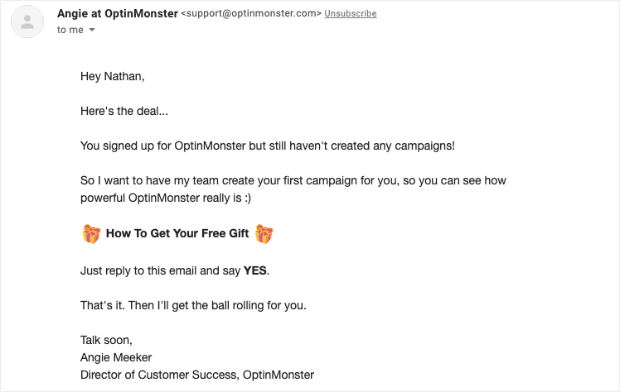
However, send HTML emails from your business. That way, you can include some branding elements that make your emails more memorable and helps with engagement.
You can include your brand name at the top:
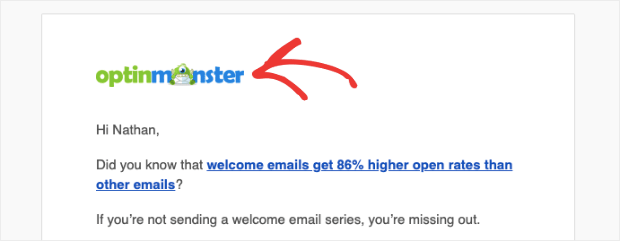
As well as a compelling call to action button at the bottom:

We’ve tested plain text versus branded emails with our email list and found that the branded emails get higher engagement.
It’s definitely a good thing to try with your own list.
However, you need to follow some best practices for sending HTML emails so they don’t get marked as spam:
- Use a maximum width of 600-800 pixels
- Keep your HTML code as clean and straightforward as possible
- Keep your image-to-text ratio low
- Optimize your images
- Don’t use obscure fonts
- Optimize for mobile
To give you an example, here is one of the branded HTML emails that our subscribers love:
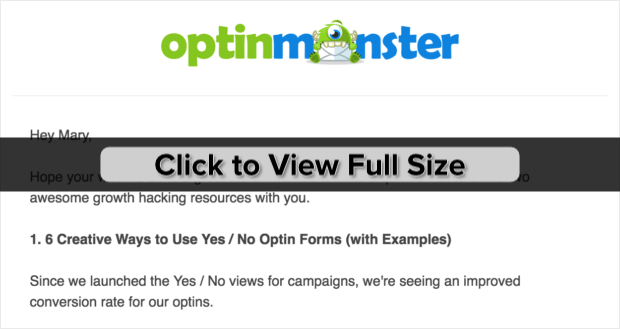
See how simple it is? We include our logo at the top for brand recognition, but most email is text.
We also use a simple visual cue, the gray box at the bottom, to highlight the “You are receiving this email because…” area.
This makes the email scannable and reminds subscribers about the benefits of being on our email list.
Alright, so all of this information has been awesome. And now you know why your emails are going to spam instead of to your subscribers’ inboxes as they should.
But let’s turn our attention to seven ways to be proactive and ensure you’re getting higher engagement rates.
13. Your Email Isn’t Properly Authenticated
Without SPF, DKIM, and DMARC, inboxes can’t trust you. Set up authentication properly.
Why is this a problem?
Lack of proper authentication is a common reason why your marketing emails end up in the spam folder. It also makes it easier for spammers and phishers to use your brand to send deceptive emails, including malware or attempts to fraud.
Here’s the solution:
By implementing smart email authentication standards, you can protect your domain and help email clients distinguish between legitimate emails and spam.
To troubleshoot spam issues, start by ensuring you have set up SPF (Sender Policy Framework) correctly. SPF establishes a list of approved sending IPs for your domain.
Additionally, make sure your emails are signed using DKIM (DomainKeys Identified Mail), a security standard that verifies message integrity.
Lastly, correctly configuring DMARC (Domain-based Message Authentication, Reporting, and Conformance) can prevent phishing attempts and scammers from using your domain, safeguarding your domain reputation and deliverability.
14. Your Email Attachments Trigger Spam Filter
Attachments can signal malware risk. Link to downloads instead of sending files directly.
Why is this a problem?
Including attachments in your emails can sometimes trigger spam filters, especially if the attachments are of types commonly used to spread malware (like .exe files).
Here’s the solution:
Be cautious when sending attachments, especially to new subscribers or recipients. Instead of attachments, consider providing links to download files from a trusted source or cloud storage.
15. You’re Sending Emails Inconsistently
Inconsistent send patterns look suspicious. Establish a steady rhythm to build sender trust.
Why is this a problem?
If you send emails at irregular volumes, especially if there’s a sudden spike, it can trigger spam filters.
Here’s the solution:
Try to maintain a consistent email-sending frequency. Avoid sudden spikes in email volume, which can be seen as spammy behavior.
Spam Risk Comparison Table
| Reason | Spam Risk | Fix Summary |
|---|---|---|
| You Aren’t Targeting the Right Audience | High | Use segmentation and behavioral targeting with OptinMonster |
| You Don’t Have Permission to Email Subscribers | High | Use explicit opt-ins and comply with GDPR/CAN-SPAM |
| Your IP Address Is or Has Been Used for Spam | High | Use a reputable ESP like Constant Contact or Drip |
| You Have Low Engagement Rates | Medium | Improve subject lines, send time, and list hygiene |
| Your Subscribers Don’t Remember You | Medium | Use consistent branding and personalization |
| You Have Low Mailbox Usage | Low | Remove inactive subscribers with win-back campaigns |
| Your Subject Line is Misleading | High | Write clear, non-clickbaity subject lines |
| Your “From” Information Is Inaccurate | High | Use recognizable sender names and emails |
| You Don’t Include Your Physical Address | Medium | Add business address to email footer |
| You’re Not Adding an Unsubscribe Button | High | Include visible unsubscribe or preferences link |
| You’re Using Spam Trigger Words | Medium | Avoid known spammy words in subject/body |
| Your HTML Emails Don’t Follow Best Practices | Medium | Use mobile-friendly, clean HTML formatting |
| Your Email Isn’t Properly Authenticated | High | Set up SPF, DKIM, and DMARC |
| Your Email Attachments Trigger Spam Filter | Medium | Link to files instead of attaching them |
| You’re Sending Emails Inconsistently | Medium | Establish a regular email sending cadence |
Here’s a quick-reference matrix ranking the spam risk for each reason and how to fix it.
How Do I Stop My Emails From Going to Spam
Now that you know the theory behind email deliverability issues and the 15 reasons why inbox identifies your message as spam email, you’re ready to take action. Follow our seven tips to get into your customer’s inbox.
1. Use OptinMonster’s Lead Verification System, TruLead®
A major benefit of using OptinMonster to grow your list is that you can use their original lead verification algorithm, TruLead®.
TruLead® lets you verify your users’ email addresses to make sure that only the highest quality leads are making it to your list.
With their lead verification system, you can block email submissions with:
- Specific IP addresses
- Special characters, strings of characters, or patterns
- Free email accounts (like Gmail, Yahoo, or Hotmail)
- Role-based emails (help@, info@, support@, and so on)
- And much more
Verifying your leads with TruLead® saves you tons of money in the long run. That’s because most email service providers charge by the number of contacts on your list.
If half of your list is made from spam submissions, then you’re paying extra money for worthless leads.
Plus, TruLead® helps you earn more money over time. That’s because all your email campaigns will go to the right people, so you can expect to generate higher conversions.
Finally, deliverability rates will increase because more people engage with your email campaigns. Higher open and click-through rates will ensure that your emails go directly to your customers’ primary inbox where they belong.
In the end, OptinMonster is the best tool for making sure that your emails don’t end up in your user’s spam folder.
Want to see OptinMonster and TruLead® in action? Sign up for your risk-free OptinMonster account today!
Then you can sign up for TruLead® for 30 days, totally free. This lets you try out the lead verification system at zero risk.
2. Target the Right Customers From the Start
We’ve already touched on this at the start of the post. But it’s the best way to make sure you don’t get your email campaigns flagged as spam.
You need to use OptinMonster to target the right audience to your email list. Fortunately, we make that ridiculously simple. You have SO many options for targeting your ideal buyer persona, including:
- Referrer Detection
- Geo-Location Targeting
- Page-Level Targeting
- Cookie Retargeting
And more.

But then we also have a list of triggers that help you identify the right subscribers by their interactions with your site.
For example, you could show your optin campaigns after a user has scrolled a certain length of your blog content. Or you could trigger campaigns based on which social media platform your user is coming from.
With OptinMonster, you can make sure that you’re only adding subscribers to your list who are genuinely interested in your content, products, or services. That will reduce the chance of your emails getting marked as spam and increase engagement rates.
3. Use Double Optins From the Start
Another way you can use OptinMonster to prevent your emails from going to spam is to use our double optin feature.
A double optin asks your users to confirm that they would like to be added to your email list after they optin. It looks something like this:
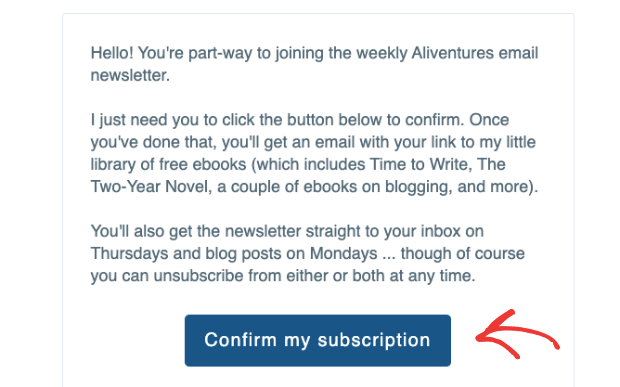
This helps because sometimes you can get false subscribers by spambots. When that happens, you can expect your open rates to plummet.
By using OptinMosnter’s double optin feature, you can make sure the people on your email list are only those who genuinely want more of your content, products, or services.
4. Use WP Mail SMTP
Many of our clients choose not to use an email service provider. Instead, they send their email campaigns directly through WordPress. If you’re in a similar boat, then you need to use WP Mail SMTP:

Over 1,000,000 websites have used WP Mail SMTP to make sure email campaigns go to the right place and are not marked as spam.
It’s also easy to configure. The WP Mail SMTP team will set everything up for you, saving you hours of headaches. Then, you simply need to craft the right email copy and hit send.
Wp Mail SMTP will make sure your emails are appropriately authenticated and sent via trusted 3rd parties. This will guarantee your email campaigns aren’t incorrectly labeled as spam.
5. Tell Subscribers to Whitelist Your Emails
When you send welcome emails to your new subscribers, tell them to whitelist your emails. This is basically asking your subscribers to tell their email client you aren’t spam.
Not sure how to set that up? Check out this resource on how to whitelist an email address with Gmail, Outlook, or Yahoo.
This is a simple action that helps in a couple of ways.
For starters, subscribers can be sure they’ll keep receiving the emails they signed up for. Also, having more people whitelist your emails will increase your sender reputation, and your inbox delivery rates will be higher overall.
Again, you’ll want to do this in your welcome email. Your readers are still excited about the content they just signed up for, and your brand is fresh on their minds.
This is the perfect time to ask them to whitelist your future content.
6. Tell Gmail Users to Drag Emails from Other Tabs to Primary Inbox
Even if your email didn’t go to spam, Gmail users might still have trouble finding your emails because they have been filtered into other tabs like Social or Promotions.
We classify these as spam because, let’s face it, people rarely look in these folders either.
To prevent this, simply ask your subscribers to drag your emails from their Promotion folder to the Primary folder.
Here’s what that looks like from an email we got from MemberPress:

Now, your Gmail subscribers will always receive your emails in their primary inbox.
7. Teach Subscribers How to Keep Your Emails Organized
Your emails are important to your subscribers, but they also get a lot of other emails. Help them find your emails easily by teaching them how to organize them into a special folder.
Also, remember that engagement significantly affects your inbox placement rates. Helping your subscribers keep track of all your future emails will help keep your emails out of spam for good.
Give your subscribers these instructions to help them organize emails from you:
How to Organize Emails
- Create a special folder where you can archive emails after you have read them.
- Don’t set up filters to automatically direct emails into these folders, or you may miss something.
- After you’ve finished reading an email, manually move it to the folder.
You would be surprised how many of your readers would gladly set up this special folder for your future emails. One of the biggest reasons many people don’t organize their inboxes this way is that many companies fail to ask.
Now that you have seven ways to prevent your emails from going to spam, we’ll look at a few more resources to help you stay in your readers’ inbox.
We’re talking, of course, about running your emails through spam filters before hitting Send.
Spam Filter Testing and Spam Checkers
Still worried that your emails might go to spam? If you follow all of the above tips, and you’re still having a problem with your emails getting sent to spam, here are some spam checkers that you can use to test your emails for issues.
1. Litmus

Litmus is a suite of email optimization tools that includes a spam checker. Here’s how it helps you keep emails going to spam:
- Scans your emails by all the major spam filters before sending to make sure that they pass
- Checks your reputation by looking at your IP addresses and any domain names used in your email and checking them against known blacklists
- Verifies that your email authentication, such as DKIM, DomainKeys, SenderID, and Sender Policy Framework, is set up correctly
- Gives you a spam score, which advises you on why you got that score and how to improve it
2. Mail-Tester
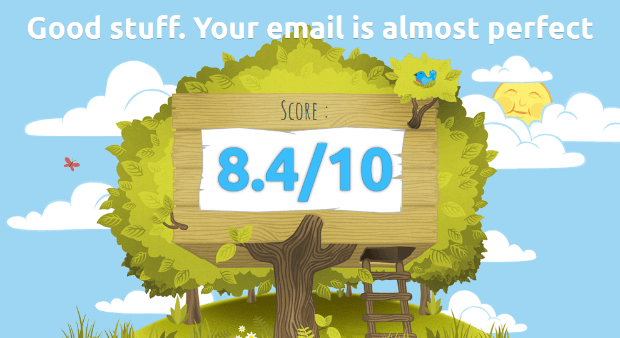
Mail-Tester is a free spam-checking tool that gives you an easy-to-understand score out of 10 on a scale of spamminess.
You’ll have to check each email manually, but it checks to see if you’re blacklisted, DKIM, and the quality of your email message, as well as doing a SpamAssassin check.
3. IsNotSpam.com

IsNotSpam is a free spam checker that you can try if you don’t have the budget for Litmus.
You’ll have to check each mail manually, and it doesn’t have a comprehensive testing capability. Still, it will check your Sender Policy Framework, SenderID, and DKIM to make sure they’re set up properly, and it will do a SpamAssassin check to score your email content.
Exclusive Bonus
Download our free Email Deliverability Checklist to make sure your emails always reach the inbox!
We hope that this guide helped you answer 2 key questions:
- Why are my emails going to spam?
- How to Stop Emails Going to Spam?
While numerous factors can land your emails in the dreaded spam folder, having a robust tool like OptinMonster can be a game-changer.
As the article highlights, OptinMonster is not just about creating captivating opt-in forms; it’s a comprehensive platform designed to enhance your email deliverability.
With features like targeted opt-in campaigns, lead verification, and double opt-in functionalities, OptinMonster ensures that your emails are sent to genuinely interested subscribers, reducing the chances of being flagged as spam.
Moreover, its analytics can provide insights into subscriber behavior, helping you refine your email strategy for optimal engagement.
So, if you’re looking to elevate your email marketing game and ensure your messages land right where they should, OptinMonster is the tool you’ve been searching for.
Don’t let your efforts go unnoticed; choose OptinMonster and make every email count!
BONUS: Done-For-You Campaign Setup ($297 value)
Our conversion experts will design 1 free campaign for you to get maximum results – absolutely FREE!
FAQs
1. Why are my emails going to spam in Gmail?
Overlooking Engagement Metrics: Gmail places a high importance on user engagement. If recipients frequently delete your emails without reading, Gmail might start directing your emails to spam.
Violation of Gmail Policies: Not adhering to Gmail’s bulk sender guidelines can result in emails being marked as spam. Ensure compliance with their policies.
Feedback Loops: Not using feedback loops to understand why users mark your emails as spam can prevent you from making necessary adjustments.
2. Why are my emails going to spam all of a sudden?
Changes in Email Algorithms: Email providers constantly update their spam filters. Even small changes in their algorithms can affect your email deliverability.
Sender Reputation Decline: If your emails suddenly start getting marked as spam by recipients, it can quickly harm your sender reputation.
Blacklisting: Your sending domain or IP could have been blacklisted by major email providers if they detect suspicious activity.
3. How do I fix incoming emails going to spam?
Adjust Spam Filters: Check your email settings and adjust the spam filters to be less aggressive. Be cautious as this might increase the risk of actual spam getting through.
Mark as Not Spam: Regularly check your spam folder. If legitimate emails are found, mark them as “Not Spam” to train your email provider about your preferences.
Add to Contacts: Adding the sender’s email address to your contacts list can help ensure their emails arrive in your inbox.

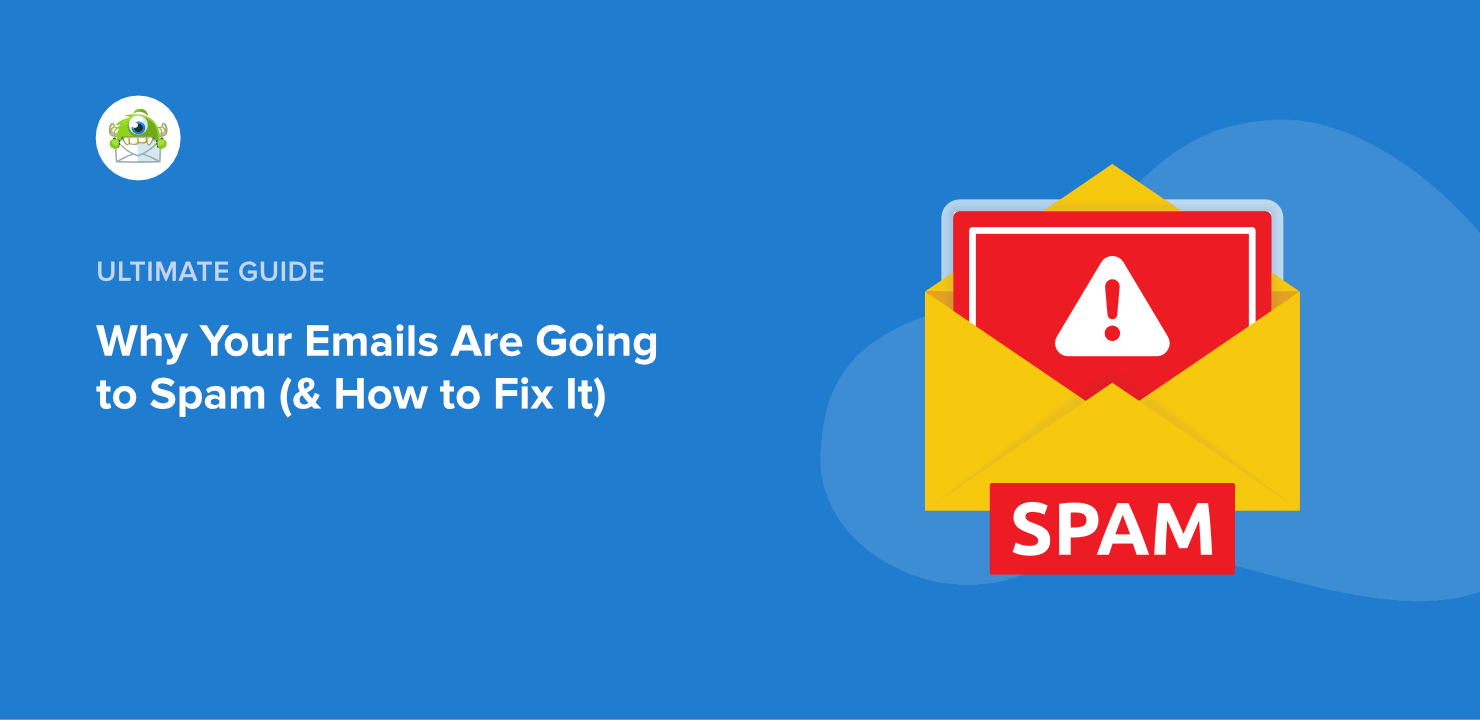











Add a Comment